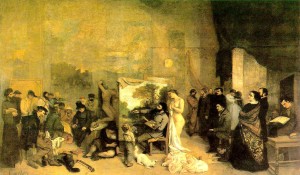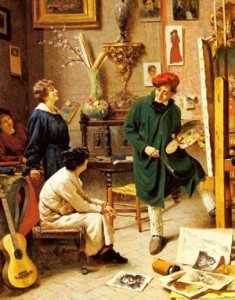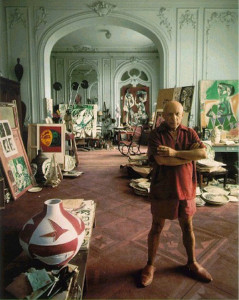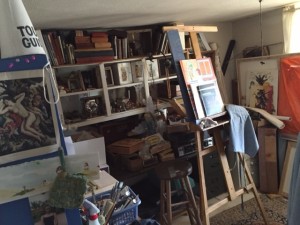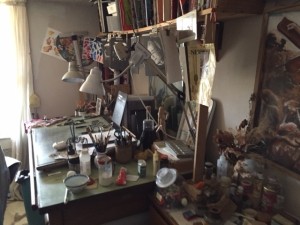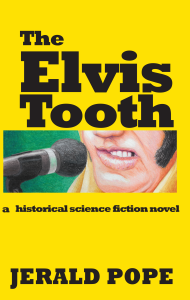 “The Elvis Tooth” is a novel, set in Black Mountain, North Carolina, in which a tourist is inexplicably sent from 2013 to 1948. He desperately wants to get back as he is due to get married in a few days and he thinks it might be awkward if he didn’t show up. He works his way back and along the way discovers some truths about the past, the present and the value of nostalgia.
“The Elvis Tooth” is a novel, set in Black Mountain, North Carolina, in which a tourist is inexplicably sent from 2013 to 1948. He desperately wants to get back as he is due to get married in a few days and he thinks it might be awkward if he didn’t show up. He works his way back and along the way discovers some truths about the past, the present and the value of nostalgia.
So, how did I come up wit this idea?
Three things drove me to write this book. (All my art is created out of a desire to get an insistent idea out of my head. Some ideas won’t go away – I have to write or draw them out.)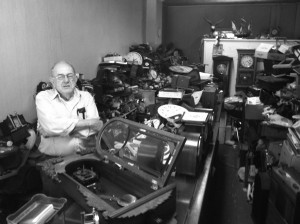
First, a crazy little clock store that has literal piles of clocks in it. It seems like a sort of elephant’s graveyard for clocks. The name: Pellom’s Time Shop, has all sorts of nuances that set my mind a play.
Second, the old dance hall above the hardware store where I worked. No one was sure what had gone on there, but it was certainly a secret side of the is little Norman Rockwell town. As I went up and down the stairs, I composed the beginning of the story that became “The Elvis Tooth.”
And third, the stories I had gathered doing oral history for the town. We put a lot of them in plays, but some we didn’t and some were too good not to use again.
And fifth, the title; I thought that was a great title for a book. Finding myself this deep in the story, I had to write myself out of it!
Art and “American Sniper”
 I saw “American Sniper” last night and thought it was a good, post-modern war movie. It had all the tropes a war movie needs: hero, battles, two dimensional enemies, sacrifice, tender moments, and triumphant resolution. But it also, if you can see them, presents the moments of doubt, pathos, and dehumanizing that my left wing compatriots are so up in arms about it lacking. The Chris Kyle I saw was a simple, straight forward cowboy who wanted to serve his country, and did so doing what he did best- shooting long distances. I saw a decent man, deadened inside by the arcade-like quality of his work, whose manly facade would not admit doubt – his or those of his wife and (a few) fellow soldiers.
I saw “American Sniper” last night and thought it was a good, post-modern war movie. It had all the tropes a war movie needs: hero, battles, two dimensional enemies, sacrifice, tender moments, and triumphant resolution. But it also, if you can see them, presents the moments of doubt, pathos, and dehumanizing that my left wing compatriots are so up in arms about it lacking. The Chris Kyle I saw was a simple, straight forward cowboy who wanted to serve his country, and did so doing what he did best- shooting long distances. I saw a decent man, deadened inside by the arcade-like quality of his work, whose manly facade would not admit doubt – his or those of his wife and (a few) fellow soldiers.
So, art.
We see what we want to see. Think of Riefenstahl’s “Triumph of the Will.” Today, we find it chilling and discuss the fascist film techniques that make it so. But Germans of the day probably found it uplifting and beautiful. And, significantly, if the film had been about the US, our immediate ancestors would generally have had the same reaction. The movie “Mash” was a bold middle finger to the establishment when it came out. I watched it recently and was appalled by the blatant sexism. The movie didn’t change; I did.
Context helps.
I was not a particular fan of Pablo Picasso’s work until I saw a series of photographs of him working on “Guernica.” What is fascinating about his work is his process. How he got from, say, the five naked women sitting in front of him (reality) to the image he abandoned on the canvas, “le demoiselles d’avignon” (art). His genius was to break away from the necessity of depicting reality ( which art can never do, anyway) and explore form and color. Fascinating.
So, “American Sniper.”
Clint Eastwood knows how to construct a good movie, And this one is good on it’s own terms. It’s even good for someone who believes Iraq was a mistake and that war has consequences for the survivors. If you’re old-school “my country, right or wrong,” you can love this movie and Chris Kyle’s life on those terms. If you’re a post-colonial American, Eastwood has touched on those hesitancies, which I understand were not in the book.
You see the movie, or the painting you want to see.
Inside the artist’s studio
How is sausage made? What REALLY goes on in an operating room? What do super-models talk about when they’re not pouting? These questions have plagued mankind for generations. Another, perhaps lesser, subject of conjecture has been the goings on in that cauldron of creativity, the art studio. Here’s the classic image:
Just a bunch of folks hanging out with Courbet while he creates a masterpiece. I especially like that there’s a semi-clothed metaphor looking over his shoulder. Nudity is a reoccurring theme:
As is the artist’s sartorial selections:
Reality, unfortunately, is not so romantic, or even Romantic. Here’s a guy you might know….
Well, Picasso probably deserved an entire mansion for a studio. By way of comparison, images from my little (too little) den of artiquity:
Notice there’s no room for a semi-clothed metaphor, even if I had one.
